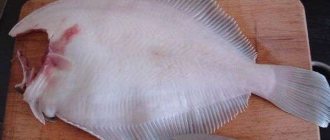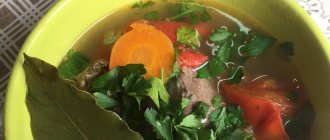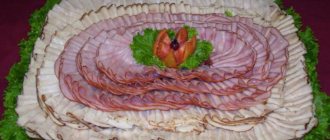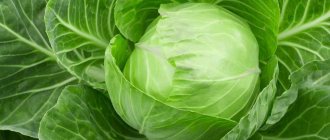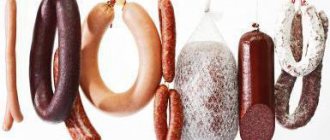There are very few foods on Earth rich in healthy omega-3 fatty amino acids, which are necessary for normal life. They enter the body exclusively from food, since humans cannot synthesize them on their own. What is the source of omega-3? In fact, there is not much choice. Oils, some types of nuts and legumes, certain representatives of cereals, vegetables and fruits, but the leader in the content of “correct” fats is fish and seafood. In the article we will look at what else this product is useful for, and also provide tables of fish fat content and its calorie content.
The role of omega-3 for humans
What makes fish healthy is the presence of “good” fats in its composition, which must be included in the human diet. The list of problems that omega-3 helps solve and prevent is quite impressive. Here's what makes this valuable component:
- participates in the construction of the nervous and endocrine systems;
- stabilizes brain function;
- normalizes heart function;
- thins the blood, preventing the formation of blood clots;
- accelerates metabolic processes;
- removes “bad” cholesterol from the body;
- relieves foci of inflammation;
- increases immunity;
- helps maintain normal blood pressure;
- improves the appearance of skin, hair and nails;
- prevents skin diseases;
- reduces the risk of developing eye diseases;
- maintains proper sugar levels;
- prevents the development of joint diseases;
- normalizes hormonal levels;
- helps cope with stress and nervous overload, prevents depression;
- plays a key role in the normal development of the fetus during pregnancy.
And that is not all! Omega-3 increases the body's endurance, gives tone, increases performance, replenishes energy costs, fights chronic fatigue syndrome, and helps cope with physical activity.
Fish and seafood rich in omega-3
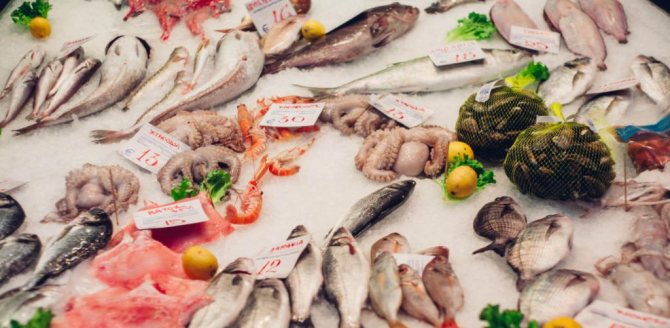
Fatty fish contain large amounts of omega-3 fatty acids and are also an excellent substitute for heavier, more difficult-to-digest meat products. Medium-fat fish is often included in dietary and sports menus, since, on the one hand, it contains a sufficient level of “correct” fat and high-quality protein, and on the other hand, medium-fat varieties are well absorbed by the body. Low-fat varieties of fish, as well as almost all seafood, are ideal for a healthy and dietary diet, as they are light and nutritious food. Below is a table of omega-3 content in popular varieties of fish and seafood.
| Name | Omega-3 content (per 100 g) |
| Fish fat | 99,8 |
| Cod liver oil | 10-21,00 |
| Caviar (black/red) | 6,8 |
| river eel | 5,6 |
| Mackerel | 2,7-5,3 |
| Herring, trout | 2-2,4 |
| Salmon | 2,5-2,6 |
| Halibut | 1,76 |
| Sardines (Atlantic), whitefish | 1,5-1,8 |
| Sprat | 1,4-3,5 |
| Salmon (canned) | 1,8 |
| Sardines (canned) | 1 |
| Shark, swordfish | 0,8 |
| Halibut | 0,7-1 |
| Pink salmon | 0,7 |
| Mussels, conger eel | 0,6 |
| Flounder, mullet, carp | 0,5-0,6 |
| Squid, oysters | 0,4-0,6 |
| Shellfish | 0,4 |
| Octopus | 0,3 |
| Shrimps | 0,2-0,5 |
| Perch | 0,2-0,6 |
| Crustaceans | 0,2-0,4 |
| Tuna | 0,2-0,3 |
| Pike perch, cod, scallop | 0,2 |
| Catfish, pike, bream | 0,1 |
A person needs to consume 1 g of omega-3 daily, and fish is an excellent source of this fatty acid. But this is far from the only advantage of this product.
Calorie content of meat. The benefits and harms of different meats
Fish is rich in vitamins, fish oil, minerals; it is especially worth highlighting its saturation with iodine and phosphorus. However, it must be taken into account that the food value of fish is specific. On the one hand, there are benefits from minerals, on the other, fish (except for certain varieties) is a very fatty food. Which will not suit many people who watch their figure. However, there are cooking methods for fish (hello steamer!) that will turn it into a real delicacy.
| per 100 grams of product: | Belkov | Zhirov | Carbohydrates | Calories |
| Beluga | 23,5 | 4 | 0 | 131 |
| Beluga fresh | 16,8 | 7 | 0 | 255 |
| Hot smoked pink salmon | 23,2 | 7,3 | 0 | 161 |
| Beluga caviar granular | 26,8 | 16 | 0 | 257 |
| Chum salmon caviar | 13,4 | 16,3 | 0 | 258 |
| Red caviar | 31,4 | 13,8 | 0 | 258 |
| Pollock caviar | 28,1 | 2 | 0 | 132 |
| Pressed black caviar | 35,8 | 18,1 | 0 | 315 |
| Boiled squid | 30,5 | 2 | 0 | 141 |
| Flounder | 16,1 | 2,6 | 0 | 99 |
| Carp | 16 | 3,5 | 0 | 249 |
| Fried carp | 18,2 | 11,5 | 0 | 195 |
| Boiled mullet | 19 | 4,2 | 0 | 114 |
| Smoked cod | 23,3 | 0,9 | 0 | 112 |
| Fish cutlets | 12,3 | 5,7 | 16 | 167 |
| Crab sticks | 5,1 | 4,1 | 9,4 | 94 |
| Boiled crabs | 18,4 | 0,9 | 0 | 86 |
| Shrimps | 18 | 0,5 | 0 | 100 |
| Bream | 16,9 | 4,2 | 0 | 98 |
| Tench | 0 | 0 | 0 | 38 |
| Salmon | 0 | 0 | 0 | 177 |
| Mussels | 0 | 0 | 0 | 67 |
| Sea kale | 0,8 | 0 | 0,4 | 4 |
| Perch | 17,5 | 5,1 | 0 | 198 |
| Fried perch | 18,9 | 8,6 | 0 | 156 |
| Lobster | 0 | 0 | 0 | 83 |
| Sturgeon | 16,2 | 11 | 0 | 101 |
| Halibut | 19 | 2,8 | 0 | 262 |
| Cod liver | 4,1 | 65,8 | 0 | 614 |
| Boiled crayfish | 20,1 | 1 | 0,7 | 95 |
| Saira in oil | 18 | 23,3 | 0 | 281 |
| Sardine in oil | 18 | 19,8 | 0 | 246 |
| Boiled sardine | 19,8 | 10,9 | 0 | 175 |
| Sevruga fresh | 17,1 | 11,8 | 0 | 180 |
| Herring | 17,7 | 19,2 | 0 | 397 |
| Atlantic salted herring | 19 | 19 | 0 | 252 |
| Boiled salmon | 16 | 14,7 | 0 | 209 |
| Mackerel | 18 | 8,7 | 0 | 384 |
| Mackerel in oil | 13,1 | 25 | 0 | 277 |
| Cold smoked mackerel | 23,2 | 6,5 | 0 | 149 |
| Som | 16,5 | 8,5 | 0 | 159 |
| Horse mackerel | 18,6 | 4,9 | 0 | 110 |
| Sterlet | 17,6 | 6 | 0 | 78 |
| Zander | 19 | 0,6 | 0 | 172 |
| Cod | 17,6 | 0,5 | 0 | 148 |
| Boiled cod | 16,8 | 0,4 | 0 | 73 |
| Tuna | 22,8 | 0,8 | 0 | 297 |
| Tuna in its own juice | 21 | 0,7 | 0 | 96 |
| Smoked eel | 17,8 | 32,3 | 0 | 361 |
| Boiled oysters | 13,8 | 3 | 0 | 94 |
| Boiled trout | 15,6 | 2,7 | 0 | 88 |
| Boiled hake | 16,4 | 2,1 | 0 | 86 |
| Hake, hake | 16,3 | 1,9 | 0 | 79 |
| Sprats in oil | 17,5 | 32,3 | 0 | 362 |
| Pike | 18,6 | 0,8 | 0 | 164 |
| Boiled pike | 17,7 | 0,5 | 0 | 78 |
What makes fish healthy is the presence of “good” fats in its composition, which must be included in the human diet. The list of problems that omega-3 helps solve and prevent is quite impressive. Here's what makes this valuable component:
- participates in the construction of the nervous and endocrine systems;
- stabilizes brain function;
- normalizes heart function;
- thins the blood, preventing the formation of blood clots;
- accelerates metabolic processes;
- removes “bad” cholesterol from the body;
- relieves foci of inflammation;
- increases immunity;
- helps maintain normal blood pressure;
- improves the appearance of skin, hair and nails;
- prevents skin diseases;
- reduces the risk of developing eye diseases;
- maintains proper sugar levels;
- prevents the development of joint diseases;
- normalizes hormonal levels;
- helps cope with stress and nervous overload, prevents depression;
- plays a key role in the normal development of the fetus during pregnancy.
And that is not all! Omega-3 increases the body's endurance, gives tone, increases performance, replenishes energy costs, fights chronic fatigue syndrome, and helps cope with physical activity.
Fatty fish contain large amounts of omega-3 fatty acids and are also an excellent substitute for heavier, more difficult-to-digest meat products. Medium-fat fish is often included in dietary and sports menus, since, on the one hand, it contains a sufficient level of “correct” fat and high-quality protein, and on the other hand, medium-fat varieties are well absorbed by the body.
| Name | Omega-3 content (per 100 g) |
| Fish fat | 99,8 |
| Cod liver oil | 10-21,00 |
| Caviar (black/red) | 6,8 |
| river eel | 5,6 |
| Mackerel | 2,7-5,3 |
| Herring, trout | 2-2,4 |
| Salmon | 2,5-2,6 |
| Halibut | 1,76 |
| Sardines (Atlantic), whitefish | 1,5-1,8 |
| Sprat | 1,4-3,5 |
| Salmon (canned) | 1,8 |
| Sardines (canned) | 1 |
| Shark, swordfish | 0,8 |
| Halibut | 0,7-1 |
| Pink salmon | 0,7 |
| Mussels, conger eel | 0,6 |
| Flounder, mullet, carp | 0,5-0,6 |
| Squid, oysters | 0,4-0,6 |
| Shellfish | 0,4 |
| Octopus | 0,3 |
| Shrimps | 0,2-0,5 |
| Perch | 0,2-0,6 |
| Crustaceans | 0,2-0,4 |
| Tuna | 0,2-0,3 |
| Pike perch, cod, scallop | 0,2 |
| Catfish, pike, bream | 0,1 |
A person needs to consume 1 g of omega-3 daily, and fish is an excellent source of this fatty acid. But this is far from the only advantage of this product.
Fish contains easily digestible protein, which is easily digested by the body. It is also rich in vitamins A, E, F, D, which help maintain human health and beauty, and various minerals, including calcium, phosphorus, iodine, magnesium, zinc, etc.

From childhood, a person is taught that meat is an important component of his diet. It is this that gives him full vitality and strength and saturates the body with useful microelements. However, there are also opposing opinions among those who adhere to vegetarianism and veganism.
On the other hand, a person is also guided by his faith. During Orthodox fasting, a person excludes meat products and products from his diet, which has a healing and preventive effect. Muslims, for example, do not eat pork at all, and they do themselves a huge favor, since this meat contains a lot of cholesterol.

meat: types and calorie content
Most nutritionists are confident that a diet without meat is not able to satiate a person and give him enough energy for full life. The thing is. that this product contains many useful amino acids that make the body work properly. Meat contains a lot of proteins, as well as fats.
You can get a huge amount of important microelements from meat:
- zinc
- iron
- iodine
- magnesium
- potassium
- vitamin E
- vitamin A
- B vitamins
- vitamin D
It is simply impossible to imagine life without meat products. And if we talk about the benefits of meat, then first of all in this matter you need to take into account its type and the amount eaten. The meat of young animals is considered the healthiest because it contains much protein than fat. In order to saturate the body, the human norm of meat per week is half a kilogram. Not a large amount of it makes brain cells work actively, and even prevents bone fragility.
| Product name | Squirrels | Fats | Water | Calorie content per 100 grams |
| pork | 11,4 | 49,3 | 38,7 | 489 |
| beef | 18,9 | 12,4 | 67,7 | 187 |
| mutton | 16,3 | 15,3 | 67,7 | 203 |
| chicken | 20,8 | 8,8 | 68,9 | 165 |
| duck | 16,5 | 61,2 | 51,5 | 346 |
| goose | 16,1 | 33,3 | 49,7 | 364 |
| rabbit | 20,7 | 12,9 | 65,3 | 199 |
| turkey | 64,5 | 12,0 | 64,5 | 197 |
| guinea fowl | 21,1 | 16,9 | 61,1 | 254 |
| nutria | 20,8 | 10 | 66,3 | 213 |
| horsemeat | 20,2 | 7 | 72,5 | 143 |
Pork is the most common type of meat and the most beloved by modern humanity. The debate about the benefits and harms of pork continues to this day. Many nutritionists are confident that it is quite difficult for the human body, others argue that the amount of nutrients is simply irreplaceable and insist that it should be consumed regularly, but in limited quantities.
First of all, it is worth noting that the fatty layer of pork, that is, lard, has many useful microelements that ensure the health of the nervous system. Only these substances are capable of restoring nerve cells in the body, namely:
- arachidonic acid - capable of regulating human hormonal levels
- Selenium - has a beneficial effect on brain function, thereby improving a person’s mental abilities
pork
In addition to these two important substances, a number of other useful substances can be identified:
- all B vitamins are present in pork in sufficient quantities
- vitamin A
- vitamin PP
- vitamin C
- potassium
- magnesium
- phosphorus
- iron
- manganese
- sulfur
- iodine
- nickel
- chlorine
- cobalt
- tin
- zinc
- sodium
- fluorine
- molybdenum
Such a huge set of microelements confidently suggests that pork is not only possible, but necessary! In addition, under increased loads, only pork is able to restore strength in the muscles and develop them.
Beef is not as popular as pork, but nevertheless it is considered one of the healthiest types of meat. It is often included in dietary and therapeutic diets. This meat is rich in protein, and is also a source of all the amino acids important and necessary for humans. Beef differs from other meats in that it is very well absorbed by the body.

beef
Red beef meat is very rich in zinc, which means that it is incredibly beneficial for the female body. in addition, it is often included in the diet for those who periodically suffer from anemia. The harm of this meat is a rather complex issue, but all nutritionists and doctors have come to the same conclusion: cattle meat is harmful only if the animal is constantly fed with nitrates and pesticides.
Unfortunately, more and more often people who breed animals inject them with numerous antibiotics and growth hormones. This significantly degrades the quality of the meat. In addition, improper storage of meat is the cause of poisoning and consumption of harmful products. Beef cannot be thawed and frozen several times. In such cases, it becomes a source of carcinogens.
Dividing fish by fat content

Different types of seafood differ in the ratio of proteins and fats and are generally divided into 3 groups.
The classification of fish varieties is based on the fat index, which varies in the product from 0.2 to 35%. Any fish is very healthy, but for a healthy diet it is recommended to regularly consume medium-fat, and even better, low-fat varieties. The processing method also matters. The final calorie content of the dish will depend on it. Nutritionists recommend boiling and baking fish, so it will retain all its beneficial properties and will not “gain” extra calories. Table of fish varieties by fat content
| Group | % fat per 100 g | Kcal per 100 g |
| Low fat | Less than 4 | 70-100 kcal |
| Medium fat | 4-8 | 100-140 kcal |
| Fat | More than 8 | more than 200 kcal |
How to cook fish for a diet
Dietary fish is useful. The recipes for preparing it are not complicated and do not take much time. Try making baked cod with lemon juice and herbs. As a side dish, you can offer baked grilled or boiled vegetables, as well as a green salad.
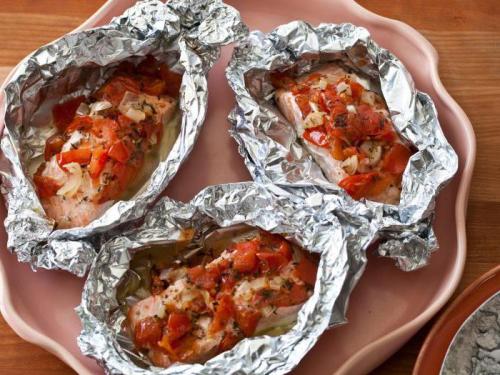
To prepare you will need:
- Cod (loin) – 320 g.
- Finely chopped parsley.
- Bulb.
- Juice of half a lemon.
- Salt.
- A little pink pepper.
- Ground white pepper.
Fish fillets should be washed and dried with paper towels. Next it should be cut. Chop the onion. Cut squares out of foil, place an onion in the center of each of them, and pieces of cod on top. Each individual portion should be salted, pepper and parsley added, and fresh lemon juice should be poured over it. Then we roll all the pieces into envelopes, put them on a baking sheet and put them in the oven, which we preheat to 220 degrees. Bake the fillet for about half an hour. So the dietary fish is ready in the oven. It is healthy and very tasty!
Low-fat fish varieties
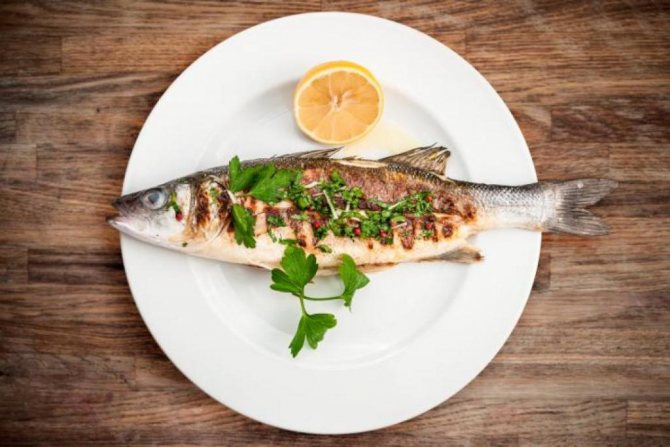
Fish is considered low-fat if its fat percentage does not exceed 4, and its energy value ranges from 70-100 kcal.
River representatives - perch, ruffe, pike, etc. Sea representatives - cod, flounder, roach, pollock, etc. This product is indispensable for diets. It contains the necessary nutritional components and is completely absorbed by the body. Fish fat content table (low fat content)
| Name | Fat content per 100 grams of product |
| Ruff | 2 |
| Pike | 1,1 |
| Cod | 0,6 |
| Flounder | 2,6 |
| Vobla (fresh) | 2,8 |
| Pollock | 0,7 |
| Hake | 2,2 |
| Perch (river) | 0,9 |
| crucian carp | 1,8 |
| Tuna | 0,7 |
Sea lean fish
In non-carbohydrate nutrition systems when losing weight, it is often advised to replace meat with fish. However, not all varieties are equally useful. In terms of calorie content, fatty mackerel is far ahead of lean pork. In order not to be mistaken, we will divide the fish according to fat content.
| Fat content per 100 grams of fish and seafood | |
| High fat content (10 g or more) | Atlantic herring, eel, sturgeon, stellate sturgeon, mackerel, sardines |
| Medium fat (from 5 to 10 grams) | Salmon (Atlantic, coho, sockeye, chinook), bluefish, catfish, rainbow trout, swordfish, catfish, capelin, carp, chum salmon, salmon, pink salmon |
| Low Fat (2 to 5 grams) | tilapia, halibut, mussels, sea bass, oysters, Pacific sea bass, chum salmon, tuna, hake |
| Very low fat content (less than 2 grams) | Pollock, pike, pike perch, crucian carp, cod, flounder, haddock, lobster, scallops, shrimp |
To get an idea of the fat content of seafood, pay attention to the color of the meat. If it is light, you have a lean variety of fish. The darker the fillet, the more calories. Think herring, salmon or mackerel.
Medium fatty fish
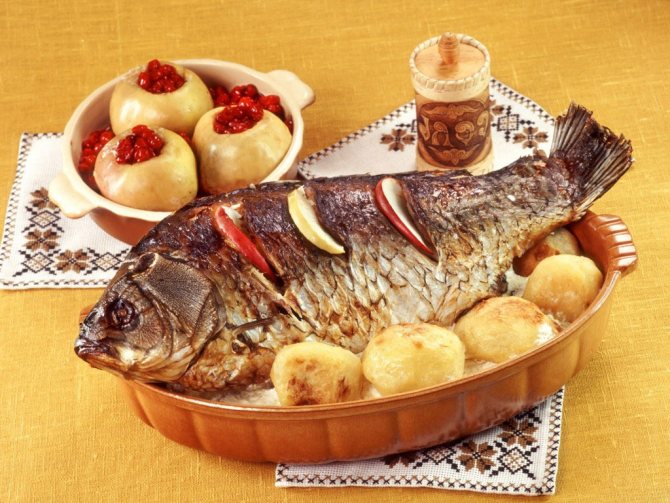
Such fish has a fat content of 4 to 8% and an energy value of 100 to 140 kcal.
The most famous river varieties are carp, catfish, trout, etc., sea varieties are chum salmon, horse mackerel, pink salmon, etc. Due to its balance, it is ideal for a healthy diet. Fish fat content table (average fat content)
| Name | Fat content per 100 grams |
| Carp | 5,3 |
| Som | 5,1 |
| Bream | 6,4 |
| Horse mackerel | 5 |
| Perch (sea) | 5,2 |
| Carp | 5,3 |
Fatty fish

The fat content of such fish starts at 8%, and the calorie content reaches 200-300 kcal.
These are saury, mackerel, beluga, ivashi, silver carp, sturgeon varieties, etc. This product is not suitable for dietary nutrition, but it is indispensable for a complete and balanced diet (in moderation!). It is these varieties that have the highest level of omega-3, as well as a lot of iodine, which helps the thyroid gland. Fish fat content table (high fat content)
| Name | Fat content per 100 grams |
| Saira | 20 |
| Mackerel | 9 |
| Ivasi | 11 |
| Silver carp | 9 |
| Acne | 27,5 |
| Herring | 19,5 |
Calorie content of fish (table)
Another important indicator for fish, as well as any product, is energy value.
For those who are watching their diet, it is important to understand how many calories are contained in a particular dish. It is logical that the fattier the fish, the higher its calorie content, but a lot will depend on the processing method. For example, flounder is a low-fat variety. When fresh, it contains only 83 kcal per 100 g. If you boil it, the finished dish will contain about 100 kcal, and if you fry it, the calorie content will almost double. This dish can no longer be called dietary. Therefore everything is relative. Below is the energy value of fresh fish per 100 grams of product, as well as the calorie content of some seafood, which is highly desirable to include in your menu. Calorie table for fish and seafood
| Name | Kcal per 100 grams |
| Ruff | 88 |
| Pike, flounder | 84 |
| Cod | 69 |
| Vobla (fresh) | 95 |
| Pollock | 72 |
| Perch (river), hake | 82 |
| Crucian carp, tuna | 87 |
| Carp | 112 |
| Trout | 120 |
| Chum salmon | 127 |
| Horse mackerel, catfish | 114 |
| Pink salmon, salmon | 140 |
| Perch (sea), bream | 103 |
| Carp, sterlet | 121 |
| Saira | 205 |
| Mackerel | 191 |
| Sturgeon | 179 |
| Beluga | 150 |
| Ivasi | 182 |
| Acne | 333 |
| Herring | 161 |
| Shrimps | 96 |
| Mussels | 77 |
| Oysters | 72 |
| Seafood Cocktail | 172 |
| Cancers | 90 |
| Crabs | 83 |
red fish

One of the favorite delicacies for many are red fish dishes.
First of all, it simply tastes amazing, and, moreover, fortunately for all fish eaters, it is incredibly healthy. Salmon, chum salmon, pink salmon, trout, sterlet, beluga, sturgeon are perhaps the most famous representatives of this class. They belong to the group of medium-fat and fatty foods and contain moderate to high calorie content. Red fish is rich in omega-3, the benefits of which we described above. In this regard, by including this product in your diet, you can strengthen almost all body systems: heart, bones, nerves, etc. Red fish fat content table
| Name | Fat content per 100 grams |
| Salmon | 15 |
| Chum salmon | 5,6 |
| Pink salmon | 5-7 |
| Trout | 6,6 |
| Sterlet | 6,1 |
| Beluga | 9 |
| Sturgeon | 11 |
Calorie content
Caloric content is the amount of energy that the body receives in the process of consuming certain foods as a result of their breakdown into simple substances. The energy value of food is measured in kilocalories (kcal). Oxidation provides the body with the following amount of energy:
- 1 g protein – 4 kcal;
- 1 g of lipid – 9 kcal;
- 1 g carbohydrate – 4 kcal.

Knowledge about the components of the product - the ability to correct your personal diet
Knowing the amount of constituent substances, you can calculate how much energy a person will receive from the food he eats.
» alt=»»>
The body's daily requirement is about 2 g per kilogram of body weight. More than half of the incoming substance should be of plant origin. When creating an individual diet, you should include those foods that are rich in proteins, but at the same time have low calorie content.
Lipids
Important! Preference should be given to olive and canola oils, as well as seafood rich in fatty acids (Omega-3)
Carbohydrates
It is better to eat foods that contain complex carbohydrates and avoid simple carbohydrates that have high glycemic indexes. A significant amount of vegetables, fruits, legumes, and berries are introduced into the diet.

